Related Research Articles

Human spaceflight is spaceflight with a crew or passengers aboard a spacecraft, often with the spacecraft being operated directly by the onboard human crew. Spacecraft can also be remotely operated from ground stations on Earth, or autonomously, without any direct human involvement. People trained for spaceflight are called astronauts, cosmonauts (Russian), or taikonauts (Chinese); and non-professionals are referred to as spaceflight participants or spacefarers.
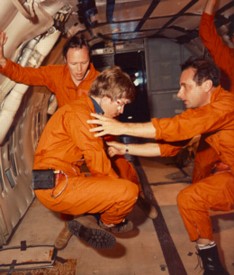
Space adaptation syndrome (SAS) or space sickness is a condition experienced by as many as half of all space travelers during their adaptation to weightlessness once in orbit. It is the opposite of terrestrial motion sickness since it occurs when the environment and the person appear visually to be in motion relative to one another even though there is no corresponding sensation of bodily movement originating from the vestibular system.

Aviation medicine, also called flight medicine or aerospace medicine, is a preventive or occupational medicine in which the patients/subjects are pilots, aircrews, or astronauts. The specialty strives to treat or prevent conditions to which aircrews are particularly susceptible, applies medical knowledge to the human factors in aviation and is thus a critical component of aviation safety. A military practitioner of aviation medicine may be called a flight surgeon and a civilian practitioner is an aviation medical examiner. One of the biggest differences between the military and civilian flight doctors is the military flight surgeon's requirement to log flight hours.

Venturing into the environment of space can have negative effects on the human body. Significant adverse effects of long-term weightlessness include muscle atrophy and deterioration of the skeleton. Other significant effects include a slowing of cardiovascular system functions, decreased production of red blood cells, balance disorders, eyesight disorders and changes in the immune system. Additional symptoms include fluid redistribution, loss of body mass, nasal congestion, sleep disturbance, and excess flatulence. Overall, NASA refers to the various deleterious effects of spaceflight on the human body by the acronym RIDGE.
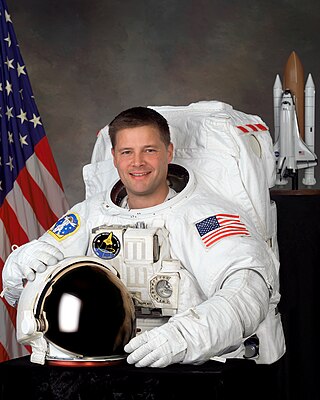
Douglas Harry "Wheels" Wheelock is an American engineer and astronaut. He has flown in space twice, logging 178 days on the Space Shuttle, International Space Station, and Russian Soyuz. On July 12, 2011, Wheelock announced that he would be returning to active duty with the United States Army in support of Operation Enduring Freedom. He is currently working with NASA to test the Orion spacecraft at the Glenn Research Center in Plum Brook, Ohio.
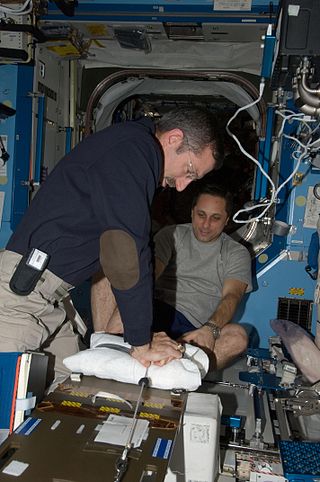
Space medicine is a specialized field under aerospace medicine that focuses on the medical care of astronauts and spaceflight participants. The spaceflight environment poses many unique stressors to the human body, including G forces, microgravity, unusual atmospheres such as low pressure or high carbon dioxide, and space radiation. Space medicine applies preventive medicine, population health, environmental health, and clinical medicine to medically screen and certify individuals for space flight; maintain their health before, during, and after space flight; and inform vehicle systems design to minimize the risk to human health and performance while meeting mission objectives.

Patricia Consolatrix Hilliard Robertson was an American physician and a NASA astronaut. She died in a plane crash the year before she would have flown to the International Space Station.

Thomas Henry Marshburn is an American physician and a former NASA astronaut. He is a veteran of three spaceflights to the International Space Station and holds the record for the oldest person to perform a spacewalk at 61 years old.
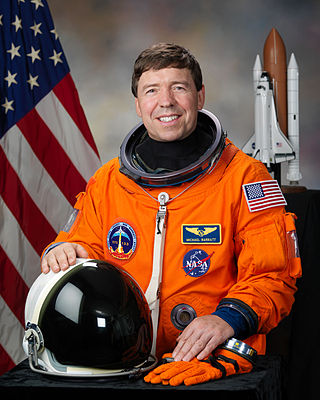
Michael Reed Barratt is an American physician and a NASA astronaut. Specializing in aerospace medicine, he served as a flight surgeon for NASA before his selection as an astronaut, and has played a role in developing NASA's space medicine programs for both the Shuttle-Mir Program and International Space Station. His first spaceflight was a long-duration mission to the International Space Station, as a flight engineer in the Expedition 19 and 20 crew. In March 2011, Barratt completed his second spaceflight as a crew member of STS-133. Barratt will pilot the SpaceX Crew-8 mission in Spring 2024.

The idea of sending humans to Mars has been the subject of aerospace engineering and scientific studies since the late 1940s as part of the broader exploration of Mars. Some have also considered exploring the Martian moons of Phobos and Deimos. Long-term proposals have included sending settlers and terraforming the planet. Proposals for human missions to Mars have come from e.g. NASA, European Space Agency, Boeing, and SpaceX. As of 2023, only robotic landers and rovers have been on Mars. The farthest humans have been beyond Earth is the Moon, under the Apollo program.
Astronautical hygiene evaluates, and mitigates, hazards and health risks to those working in low-gravity environments. The discipline of astronautical hygiene includes such topics as the use and maintenance of life support systems, the risks of the extravehicular activity, the risks of exposure to chemicals or radiation, the characterization of hazards, human factor issues, and the development of risk management strategies. Astronautical hygiene works side by side with space medicine to ensure that astronauts are healthy and safe when working in space.

Astronaut training describes the complex process of preparing astronauts in regions around the world for their space missions before, during and after the flight, which includes medical tests, physical training, extra-vehicular activity (EVA) training, procedure training, rehabilitation process, as well as training on experiments they will accomplish during their stay in space.
It is inevitable that medical conditions of varying complexity, severity and emergency will occur during spaceflight missions with human participants. Different levels of care are required depending on the problem, available resources and time required to return to Earth.

Selection, training, cohesion and psychosocial adaptation influence performance and, as such, are relevant factors to consider while preparing for costly, long-duration spaceflight missions in which the performance objectives will be demanding, endurance will be tested and success will be critical.
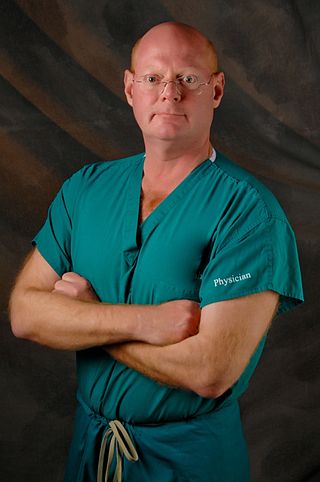
Sean Kevin Roden is a NASA flight surgeon was the lead of medical operations for the International Space Station (ISS) from 2004 to 2007.
Heart rhythm disturbances have been seen among astronauts. Most of these have been related to cardiovascular disease, but it is not clear whether this was due to pre-existing conditions or effects of space flight. It is hoped that advanced screening for coronary disease has greatly mitigated this risk. Other heart rhythm problems, such as atrial fibrillation, can develop over time, necessitating periodic screening of crewmembers’ heart rhythms. Beyond these terrestrial heart risks, some concern exists that prolonged exposure to microgravity may lead to heart rhythm disturbances. Although this has not been observed to date, further surveillance is warranted.

Psychological and sociological effects of space flight are important to understanding how to successfully achieve the goals of long-duration expeditionary missions. Although robotic spacecraft have landed on Mars, plans have also been discussed for a human expedition, perhaps in the 2030s, or as early as 2024 for a return mission.

A Mars habitat is a hypothetical place where humans could live on Mars. Mars habitats would have to contend with surface conditions that include almost no oxygen in the air, extreme cold, low pressure, and high radiation. Alternatively, the habitat might be placed underground, which helps solve some problems but creates new difficulties.
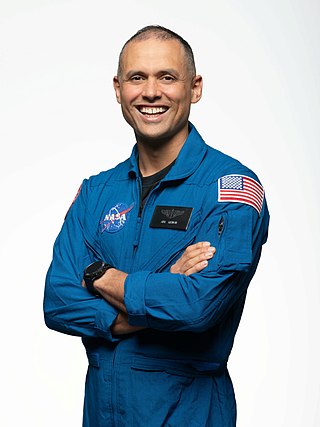
Anil Menon is a lieutenant colonel in the United States Air Force, emergency medicine physician, and NASA astronaut candidate.

Anna Menon is an American engineer scheduled to fly on Polaris Dawn, a private space mission. Menon worked for NASA for seven years before joining SpaceX, where she works as a lead engineer of space operations.
References
- ↑ Stewart, LH; Trunkey, D; Rebagliati, GS (Jan 2007). "Emergency medicine in space". The Journal of Emergency Medicine . 32 (1): 45–54. doi:10.1016/j.jemermed.2006.05.031. PMID 17239732.
- 1 2 Summers, RL; Johnston, SL; Marshburn, TH; Williams, DR (Aug 2005). "Emergencies in space". Annals of Emergency Medicine. 46 (2): 177–84. doi:10.1016/j.annemergmed.2005.02.010. PMID 16046951.
- ↑ Davis, JR (February 1999). "Medical issues for a mission to Mars". Aviation, Space, and Environmental Medicine. 70 (2): 162–8. PMID 10206937.
- 1 2 3 Ball, John R.; Evans, Charles j. (2001). Safe passage : astronaut care for exploration missions ([Online-Ausg.] ed.). Washington, D.C.: National Academy Press. ISBN 0-309-07585-8.
- ↑ Fritsch-Yelle, JM; Leuenberger, UA; D'Aunno, DS; Rossum, AC; Brown, TE; Wood, ML; Josephson, ME; Goldberger, AL (1 June 1998). "An episode of ventricular tachycardia during long-duration spaceflight". The American Journal of Cardiology. 81 (11): 1391–2. doi:10.1016/s0002-9149(98)00179-9. PMID 9631987.
- ↑ Berry, CA (September 1974). "Medical legacy of Apollo". Aerospace Medicine. 45 (9): 1046–57. PMID 4153403. Archived from the original on 2014-04-07. Retrieved 3 July 2012.
- ↑ Lebedev, Valentin; Cassutt, C.W. Harrison; foreword by Michael (1990). Diary of a cosmonaut : 211 days in space (Bantam ed.). New York: Bantam Books. ISBN 0553287788.
- ↑ Newkirk, Dennis (1990). Almanac of Soviet manned space flight. Houston: Gulf Pub. Co. ISBN 0872018482.
- ↑ Brown, LR; Frome, WJ; Handler, S; Wheatcroft, MG; Rider, LJ (1977). "Skylab oral health studies". Biomedical Results from Skylab. Washington, D.C.: NASA: 35–44. Archived from the original on 2012-09-26.
- ↑ Glover, SD; Taylor, EW (1981). "Surgical problems presenting at sea during 100 British Polaris submarine patrols". Journal of the Royal Naval Medical Service. 67 (2): 65–9. PMID 7310747.
- 1 2 3 Tansey, WA; Wilson, JM; Schaefer, KE (1979). "Analysis of health data from 10 years of Polaris submarine patrols". Undersea Biomedical Research. 6 Suppl: S217-46. PMID 505628.
- ↑ Lisney, SJ (3 August 1976). "Dental problems in Antarctica". British Dental Journal. 141 (3): 91–2. doi:10.1038/sj.bdj.4803796. PMID 1067108. S2CID 6400390.
- 1 2 Billica, RD; Simmons, SC; Mathes, KL; McKinley, BA; Chuang, CC; Wear, ML; Hamm, PB (May 1996). "Perception of the medical risk of spaceflight". Aviation, Space, and Environmental Medicine. 67 (5): 467–73. PMID 8725475.
- 1 2 3 4 Buckey Jr, JC (2006). "Long-duration flight medical planning: Medical care on the way to the moon and Mars". Space Physiology. NY: Oxford University Press: 239–266.
- ↑ Osswald, S; Miles, R; Nixon, W; Celio, P (November 1996). "Review of cardiac events in USAF aviators". Aviation, Space, and Environmental Medicine. 67 (11): 1023–7. PMID 8908338.
- ↑ Lugg, D. J. (2000). "Antarctic Medicine". JAMA: The Journal of the American Medical Association. 283 (16): 2082–2084. doi:10.1001/jama.283.16.2082. PMID 10791487.
- ↑ Peterson, LE; Pepper, LJ; Hamm, PB; Gilbert, SL (February 1993). "Longitudinal study of astronaut health: mortality in the years 1959-1991". Radiation Research. 133 (2): 257–64. Bibcode:1993RadR..133..257P. doi:10.2307/3578364. JSTOR 3578364. PMID 8438068.
- ↑ Hamm, PB; Billica, RD; Johnson, GS; Wear, ML; Pool, SL (February 1998). "Risk of cancer mortality among the Longitudinal Study of Astronaut Health (LSAH) participants". Aviation, Space, and Environmental Medicine. 69 (2): 142–4. PMID 9491253.
![]() This article incorporates public domain material from Human Health and Performance Risks of Space Exploration Missions (PDF). National Aeronautics and Space Administration. (NASA SP-2009-3405, pages 242-246).
This article incorporates public domain material from Human Health and Performance Risks of Space Exploration Missions (PDF). National Aeronautics and Space Administration. (NASA SP-2009-3405, pages 242-246).